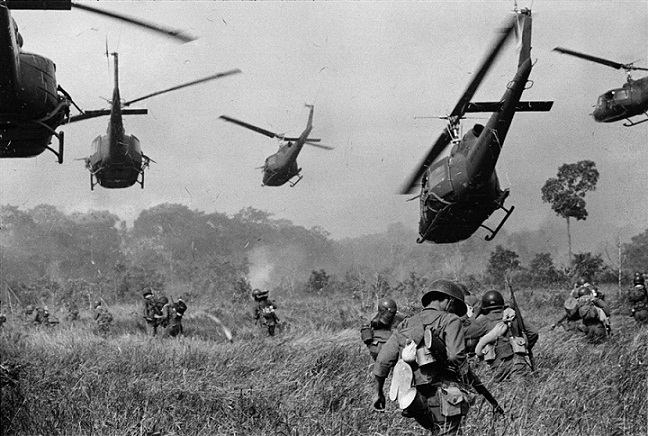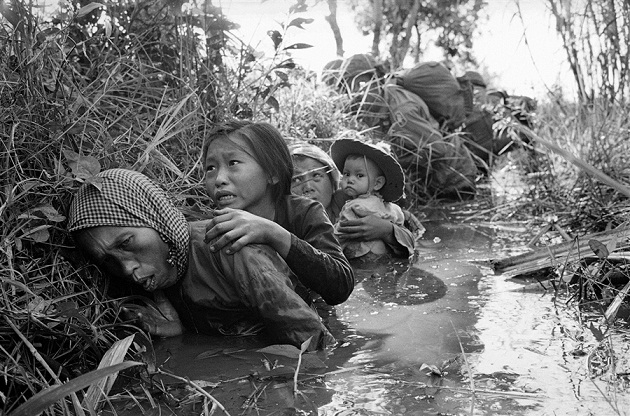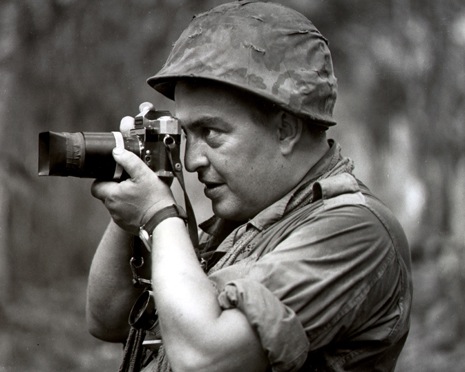Reviews & Articles
Horst Faas: Photographer & Photo Editor, 1933 - 2012
John BATTEN
at 5:40pm on 18th September 2012





Captions:
1. Hovering U.S. Army helicopters pour machine gun fire into the tree line to cover the advance of South Vietnamese ground troops in an attack on a Viet Cong camp 18 miles north of Tay Ninh, Vietnam, northwest of Saigon near the Cambodian border in March 1965.
2. Women and children crouch in a muddy canal as they take cover from intense Viet Cong fire at Bao Trai, about 20 miles west of Saigon, Vietnam, in January 1966.
3. A father holds the body of his child as South Vietnamese Army Rangers look down from their armored vehicle. The child was killed as government forces pursued guerrillas into a village near the Cambodian border.
4. Deposed Congo Prime Minister Patrice Lumumba, hands manacled, sits in the bed of an army truck under guard of Congolese soldiers after his arrival at Leopoldville (Kinshasa) airport, 2 December 1960, one day after his arrest by troops loyal to Colonel Joseph Mobutu. (Lumumba was executed the following month).
5. Horst Faas in Vietnam, 1967
All images: Horst Faas / The Associated Press
(原文以英文發表,題為《赫斯特‧法埃斯: 攝影師與圖片編輯1933-2012》。)
“The recent deaths of George Esper, photographer Horst Faas, correspondent Malcolm Browne, and writer Roy Essoyan represent the slipping away of a generation of war reporters that brought the reality of the conflict to the living rooms of America in often horrifying close-up and inspired scores of combat journalists in their wake.”
- Chris Brummitt, Associated Press correspondent, Hanoi, 29 August 2012
Horst Faas and his Vietnam photographs are seared into the hazy memory of anyone alive during the 1960s. They are familiar as great photographs, and now, exemplary of the genre for which he became famous: documentary photography; and that most harrowing of types – for both photographer and viewer – war photography.
Faas, Esper, Brown, Essoyan and New Zealander Peter Arnett were a legendary group of Associated Press correspondents amongst a legion of distinguished foreign and Vietnamese journalists and photographers that covered that most discussed, photographed and controversial of wars, the Vietnam War. They mapped the war for newspaper and magazine readers around the world, were immensely influential and provided evidence of a conflict that many considered unjustified.
Predominantly caught on Faas’ camera in this selection of photographs at the FCC is the soldier on the battlefield interacting with ‘civilians’. A moment of fate, an episode of people’s lives, stillborn; each awful, brutal, dramatic and poignant – and always in the (napalmed or fire smoldering) air is the tempered words on the soldier’s helmet, “WAR IS HELL.”
Photography also anticipates, warns and memorializes. Three months after the Republic of Congo gained independence from Belgium in 1960, a coup deposed the newly elected Prime Minister Patrice Lumumba. Faas’ photograph shows Lumumba shackled, scared. He will later be executed (and gains independence-tinged martyrdom) - in collusion with the Belgian authorities, some whose faces can be glimpsed in the background. Faas’ photograph captures the optimism of Africa’s fragile post-independence aspirations bared in the back of a truck, anticipating decades of anguish. That legacy can be seen throughout Africa by the (many decrepit) streets, avenues, squares and monuments named “Patrice Lumumba.” Faas’ image of a bound Lumumba equally resonates.
Exhibition: Photographs by Horst Faas
Date: 5 – 28.9.2012
Venue: The Foreign Correspondents' Club, Hong Kong
